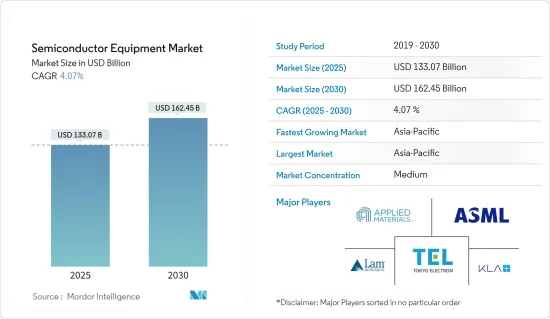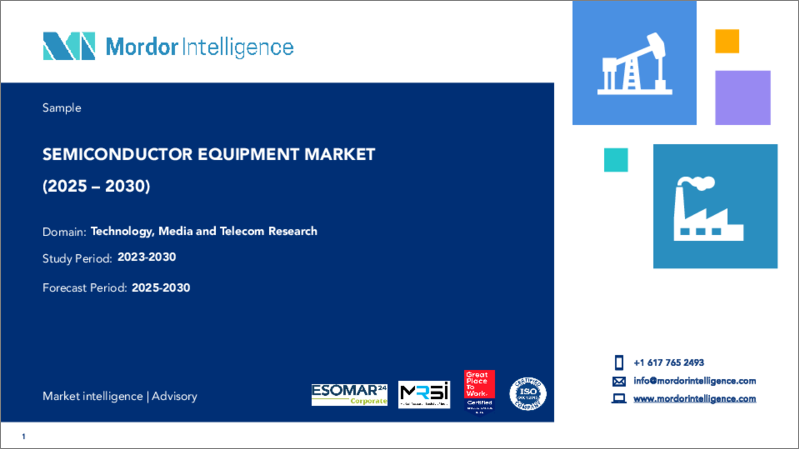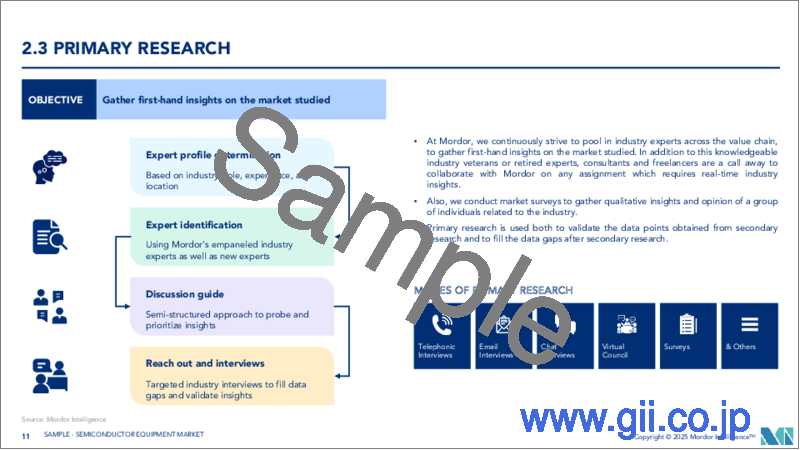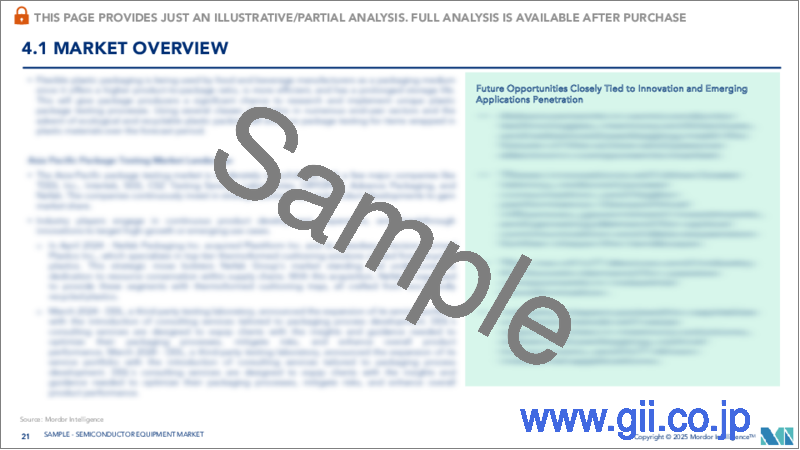|
|
市場調査レポート
商品コード
1687948
半導体機器:市場シェア分析、産業動向・統計、成長予測(2025年~2030年)Semiconductor Equipment - Market Share Analysis, Industry Trends & Statistics, Growth Forecasts (2025 - 2030) |
||||||
カスタマイズ可能
適宜更新あり
|
|||||||
| 半導体機器:市場シェア分析、産業動向・統計、成長予測(2025年~2030年) |
|
出版日: 2025年03月18日
発行: Mordor Intelligence
ページ情報: 英文 146 Pages
納期: 2~3営業日
|
- 全表示
- 概要
- 目次
半導体機器市場規模は2025年に1,330億7,000万米ドルと推計され、2030年には1,624億5,000万米ドルに達すると予測され、予測期間(2025-2030年)のCAGRは4.07%です。

世界の半導体産業は、スマートフォンや高度家電などのデバイスの同時成長、自動車産業の成長によって牽引されています。
主なハイライト
- これらの産業は、ワイヤレス技術(5G)や人工知能などの技術の変遷によって牽引されています。高性能かつ低コストの半導体需要の着実な高まりなど、いくつかの要因が短期、中期、長期にわたってさまざまな影響を与えながら市場を牽引しています。
- 5Gの展開は、市場を牽引する重要な要因の1つになると予想されます。5Gの拡大は無線産業の拡大につながり、拡張現実、ミッションクリティカルなサービス、固定無線アクセス、モノのインターネットなどのイノベーションを可能にするからです。
- さらに、ノードやウエハーサイズの微細化など、半導体業界の漸進的な変遷に伴い、超大規模集積技術のためのウエハーサイズの拡大需要が半導体機器の成長を促進しています。また、ウエハーの微細化に伴うコストアップや検査課題から、ウエハーメーカーはプロセスモニターをベアウエハーから生産用ウエハーに移行しています。
- 300mmシリコンウエハーの世界需要は旺盛で、200mmウエハー需要も近年急増しています。SEMIによると、200mmファブは2017年から2022年の間に世界中で月産60万枚以上のウエハーを追加する準備を進めています。このような動向はさらに、調査したマーケット成長のカタリストとして作用すると予想されます。
- COVID-19パンデミックは、2020年前半に世界、特に中国における半導体のサプライチェーンと生産プロセスを混乱させました。主な原因は労働力不足で、その間、いくつかの半導体企業が操業を停止しました。このため、半導体に依存する最終製品企業は逼迫しました。
半導体機器市場の動向
コンシューマーエレクトロニクスの需要増加
- コンシューマーエレクトロニクスは最も急成長している分野であり、市場拡大に大きく貢献しています。人口増加とともに増加すると予測されるスマートフォンの成長が、この市場の主要な原動力となっています。タブレット、スマートフォン、ラップトップコンピュータ、ウェアラブルガジェットなどの製品需要の増加により、コンシューマーエレクトロニクスが業界を牽引しています。半導体技術の進歩に伴い、機械学習などの新たな市場分野が急速に統合されつつあります。
- 自動車、医療機器、スマート・デバイス、スマート・ホーム、ウェアラブルなどのアイテムが改良され続けているため、半導体の統合は広範な現象となっています。また、消費者の小型化志向から、半導体をワンチップ化する動向も拡大しています。半導体を製造する機械は、半導体をワンチップに集積することを可能にし、勢いを増しています。
- 2021年末までのモバイル契約数は約82億です。2027年末には約91億件に達すると予想されます。モバイル・ブロードバンド加入の割合は、同時期に84%から93%に上昇する可能性があります。予測期間終了時には、ユニーク・モバイル顧客数は2021年末の61億人から67億人に増加すると予想されます。
- スマートフォン関連の契約はまだ増加しています。2021年末時点の契約数は63億件で、全携帯電話契約数の77%近くを占める。2027年には、全携帯電話加入者の87%に当たる78億件に増加すると予想されます。
- 半導体機器市場は、より迅速で効果的なメモリーソリューションの需要によって牽引されています。これらの半導体はより複雑化し、集中的なメモリ操作を処理できるようになっています。全体として、IPソリューション・プロバイダーへの依存度が高まっているため、市場には多額の投資が行われています。
アジア太平洋地域が大きな市場シェアを占める見込み
- 半導体機器は一部の国に非常に集中しており、一部の主要国以外での販売は非常に限られているか、存在しないです。中国は成熟した半導体技術の不可欠な生産国として大きく成長しています。その一方で、中国政府は半導体産業を経済成長と技術リーダーシップの原動力として優先させ続けています。2030年までに世界の半導体生産能力の約40%を新たに追加すると予想されています。
- さらに2022年4月には、自動テスト装置の大手サプライヤーであるテラダイン社が、中国の大手マイクロコントローラユニット(MCU)およびセキュリティ集積回路(IC)チップメーカーであるネイションズ・テクノロジーズ社に、同社のJ750半導体テストプラットフォームの7,000台目の出荷を行ったと発表しました。
- 製造機会を向上させるスマート電子デバイスの採用拡大や、様々なアプリケーションへのエレクトロニクスの大幅な統合が、日本における半導体機器の成長を促進する主な要因となっています。さらに、様々なエンドユーザー産業へのIoT、人工知能、コネクテッドデバイスの組み込みが、同国の半導体機器市場を牽引すると予想されます。
- 国際的な業界団体であるSEMIによると、自動車や高性能コンピューティングデバイスに使用されるチップの旺盛な需要により、台湾は今年、前工程のチップ製造装置に世界最大の支出を行う国になると予想されています。台湾の製造装置への支出は、年間52%増の340億米ドルに達すると予想されています。
- 韓国をはじめとする鋳造の主要拠点は、自国の産業プレゼンス拡大のため、ますます投資と奨励を強めています。加えて、通商産業エネルギー省は、チップ輸出が2030年までに2倍の2,000億米ドルになる見込みであると発表しました。さらに政府は、ソウルの南側に数十キロに及ぶ「K半導体ベルト」を構築し、チップ設計者、メーカー、サプライヤーを集結させようとしています。これらの工場は、世界のチップ不足の中、主要半導体企業とそのサプライヤーが集積して、世界の半導体産業における韓国の競争力を研ぎ澄まし、主要な半導体材料と装置供給を現地化することを目的としています。
半導体機器産業の概要
半導体機器市場の競争企業間の敵対関係は中程度に高いです。企業の専門化は、中小企業産業で競争するために必要な高額の研究開発投資と資本支出によって推進されています。主なプレーヤーには、アプライド・マテリアルズ、ASMLホールディング・セミコンダクター・カンパニー、KLAコーポレーションなどがあります。この市場における最近の動向をいくつか紹介する:
- 2022年5月:SCREENホールディングスは、半導体業界の環境負荷低減への取り組みを強化しました。しかし、半導体デバイスへの依存度が高まるにつれ、製造工程で生じる環境負荷は半導体業界共通の課題となっています。このような課題を背景に、SCREEN SPEは、世界をリードするイノベーターであるIMECが主導する「サステイナブル半導体技術・システム調査プログラム」に参加することに合意しました。同プログラムは、半導体産業全体の環境負荷低減に貢献することを目的としています。
- 2022年2月:台湾の世界半導体ファウンドリーであるユナイテッド・マイクロエレクトロニクス・コーポレーション(UMC)は、シンガポールに新たな先端製造施設を建設する計画を発表。新施設はパシール・リスにあるFab12iとして知られる既存工場の隣に建設されます。投資総額は50億米ドル。新ウエハー工場は月産3万枚の生産能力を持ち、2024年後半に生産を開始する予定です。UMCによると、この工場はシンガポールで最も先進的な半導体鋳造工場のひとつとなり、22nmと28nmのチップを生産します。
その他の特典:
- エクセル形式の市場予測(ME)シート
- 3ヶ月間のアナリスト・サポート
目次
第1章 イントロダクション
- 調査の前提条件と市場定義
- 調査範囲
第2章 調査手法
第3章 エグゼクティブサマリー
第4章 市場力学
- 市場概要
- 業界の魅力度-ポーターのファイブフォース分析
- 供給企業の交渉力
- 消費者の交渉力
- 新規参入業者の脅威
- 競争企業間の敵対関係
- 代替品の脅威
- COVID-19の業界への影響評価
第5章 市場力学
- 市場促進要因
- 民生用電子機器の需要増加
- 業界別AI、IoT、コネクテッドデバイスの普及
- 市場抑制要因
- 技術のダイナミックな性質により、製造設備に数回の変更が必要
第6章 市場セグメンテーション
- 機器タイプ別
- フロントエンド機器
- リソグラフィー装置
- エッチング装置
- 成膜装置
- 計測/検査装置
- 材料除去・洗浄装置
- フォトレジスト処理装置
- その他の機器
- バックエンド機器
- テスト機器
- 組立・包装機器
- フロントエンド機器
- サプライチェーン参入別
- IDM
- OSAT
- ファウンドリ
- 地域別
- 北米
- 欧州
- アジア太平洋
- 中国
- 日本
- 台湾
- 韓国
- 世界のその他の地域
第7章 競合情勢
- 企業プロファイル
- Applied Materials Inc.
- ASML Holding Semiconductor Company
- Tokyo Electron Limited
- Lam Research Corporation
- KLA Corporation
- Veeco Instruments Inc.
- Screen Holdings Co. Ltd
- Teradyne Inc.
- Hitachi High-Technologies Corporation
第8章 投資分析
第9章 市場機会と今後の動向
The Semiconductor Equipment Market size is estimated at USD 133.07 billion in 2025, and is expected to reach USD 162.45 billion by 2030, at a CAGR of 4.07% during the forecast period (2025-2030).

The global semiconductor industry is driven by the simultaneous growth of smartphones and other devices, such as advanced consumer electronics, and the growth of the automotive industry.
Key Highlights
- These industries are driven by technology transitions such as wireless technologies (5G) and artificial intelligence. Several factors, including a steady rise in the demand for high-performance and low-cost semiconductors, drive the market with varying impacts over the short, medium, and long term.
- The deployment of 5G is expected to be one of the key factors driving the market. This is because the expansion of 5G would lead to the expansion of the wireless industry and enable innovations like augmented reality, mission-critical services, fixed wireless access, and the Internet of Things.
- Furthermore, with the gradual transitions in the semiconductor industry, such as the miniaturization of nodes and wafer sizes, the demand for increasing the wafer sizes for ultra-large-scale integration technologies has fostered the growth of semiconductor equipment. Moreover, fab manufacturers are shifting process monitors from bare wafers to production wafers due to the higher cost and inspection challenges faced by wafer miniaturization.
- The global demand for 300 mm silicon wafers is strong, and the demand for 200 mm has also seen a surge in recent years. According to SEMI, 200 mm fabs are gearing up to add over 600,000 wafers per month across the world during 2017-2022. Such trends are further expected to act as catalysts for the growth of the market studied.
- The COVID-19 pandemic disrupted the supply chains and production processes of semiconductors worldwide, especially in China, during the first half of 2020. The primary reason was a labor shortage, during which several semiconductor companies suspended operations. This created a crunch for end-product companies that depend on semiconductors.
Semiconductor Equipment Market Trends
Increasing Demand for Consumer Electronic Devices
- Consumer electronics is the fastest-growing segment and contributes significantly to market expansion. The growth of smartphones, which is predicted to increase with population growth, is the key driving force for this market. Consumer electronics drive the industry due to the increased demand for products such as tablets, smartphones, laptop computers, and wearable gadgets. As semiconductor technology advances, new market areas, such as machine learning, are rapidly being integrated.
- Due to ongoing improvements in items, including cars, medical equipment, smart devices, smart homes, and wearables, semiconductor integration has become a widespread phenomenon. Additionally, the trend of combining semiconductors into a single chip is expanding due to the consumers' desire for small-sized devices. The machinery used to manufacture semiconductors is gaining momentum since it makes it possible to assemble semiconductors on a single chip.
- There were approximately 8.2 billion mobile subscriptions by the end of 2021. This is anticipated to reach nearly 9.1 billion by the end of 2027. The percentage of mobile broadband subscriptions may rise from 84% to 93% at the same time. By the end of the forecast period, there are expected to be 6.7 billion unique mobile customers, up from 6.1 billion at the end of 2021.
- Smartphone-related subscriptions are still increasing. There were 6.3 billion at the end of 2021, making up nearly 77% of all mobile phone subscriptions. By 2027, this is anticipated to increase to 7.8 billion, or 87% of all mobile subscribers.
- The semiconductor equipment market is driven by the demand for quicker and more effective memory solutions. These semiconductors are becoming more complicated and can handle intensive memory operations. Overall, the market is seeing significant investments due to the increased reliance on IP solution providers.
Asia-Pacific Expected to Hold Significant Market Share
- The semiconductor equipment is highly concentrated in a few countries, and sales of this equipment are very limited or non-existent outside some major countries. China has grown significantly as an essential producer of mature semiconductor technologies. On the other hand, the Chinese government continues to prioritize the semiconductor industry as a driver of economic growth and technological leadership. It is expected to add roughly 40% of the new global capacity by 2030.
- Further, in April 2022, Teradyne Inc., a leading supplier of automated test equipment, announced the shipment of the 7,000th unit of its J750 semiconductor test platform to Nations Technologies, a leading microcontroller unit (MCU) and security integrated circuit (IC) chip maker in China.
- The growing adoption of smart electronic devices that improve manufacturing opportunities and the significant integration of electronics into various applications are the key factors driving the growth of semiconductor equipment in Japan. Moreover, the incorporation of IoT, artificial intelligence, and connected devices into various end-user industries are expected to drive the semiconductor equipment market in the Country.
- Due to the robust demand for chips used in vehicles and high-performance computing devices, Taiwan is expected to become the world's largest spender on front-end chip manufacturing equipment this year, according to the international trade group SEMI. Taiwanese fab equipment spending is expected to rise by 52% yearly to USD 34 billion.
- South Korea and other major hubs for foundries are increasingly investing and incentivizing to expand the industry presence of their respective countries. In addition, the Ministry of Trade, Industry, and Energy announced that chip exports are expected to double to USD 200 billion by 2030. Furthermore, the government seeks to build a "K-Semiconductor belt" that stretches dozens of kilometers south of Seoul and brings together chip designers, manufacturers, and suppliers. These plants aim to sharpen South Korea's competitive edge in the global semiconductor industry and localize major semiconductor materials and equipment supplies with key semiconductor companies and their suppliers working in clusters amid a global chip shortage.
Semiconductor Equipment Industry Overview
The intensity of competitive rivalry is moderately high in the semiconductor equipment market. Firm specialization is driven by the high R&D investments and capital expenditures required to compete in the SME industry. Some key players are Applied Materials Inc., ASML Holding Semiconductor Company, and KLA Corporation. A few recent developments in this market are:
- May 2022: SCREEN Holdings increased its efforts to reduce the environmental impact of the semiconductor industry. However, as reliance on semiconductor devices has grown, the environmental impact created by the manufacturing processes has become a shared concern for the semiconductor industry. With this challenge in mind, SCREEN SPE agreed to join the Sustainable Semiconductor Technologies and Systems research program led by IMEC, a world-leading innovator. The program is designed to help the semiconductor industry reduce its overall environmental impact.
- February 2022: United Microelectronics Corporation (UMC), a Taiwanese global semiconductor foundry, announced its plans to build a new advanced manufacturing facility in Singapore. The new facility would be built next to its existing plant, known as Fab12i, in Pasir Ris. The total investment for the planned project was USD 5 billion. The new wafer fab facility would have a monthly capacity of 30,000 wafers, with production expected to start in late 2024. According to UMC, it would also be one of the most advanced semiconductor foundries in Singapore and will produce 22 nm and 28 nm chips.
Additional Benefits:
- The market estimate (ME) sheet in Excel format
- 3 months of analyst support
TABLE OF CONTENTS
1 INTRODUCTION
- 1.1 Study Assumptions and Market Definition
- 1.2 Scope of the Study
2 RESEARCH METHODOLOGY
3 EXECUTIVE SUMMARY
4 MARKET DYNAMICS
- 4.1 Market Overview
- 4.2 Industry Attractiveness - Porter's Five Forces Analysis
- 4.2.1 Bargaining Power of Suppliers
- 4.2.2 Bargaining Power of Consumers
- 4.2.3 Threat of New Entrants
- 4.2.4 Intensity of Competitive Rivalry
- 4.2.5 Threat of Substitutes Products
- 4.3 Assessment of Impact of COVID-19 on the Industry
5 MARKET DYNAMICS
- 5.1 Market Drivers
- 5.1.1 Increasing Demand for Consumer Electronic Devices
- 5.1.2 Proliferation of AI, IoT, And Connected Devices Across Industry Verticals
- 5.2 Market Restraints
- 5.2.1 Dynamic Nature of Technologies Requires Several Changes in Manufacturing Equipment
6 MARKET SEGMENTATION
- 6.1 By Equipment Type
- 6.1.1 Front-end Equipment
- 6.1.1.1 Lithography Equipment
- 6.1.1.2 Etch Equipment
- 6.1.1.3 Deposition Equipment
- 6.1.1.4 Metrology/Inspection Equipment
- 6.1.1.5 Material Removal/Cleaning Equipment
- 6.1.1.6 Photoresist Processing Equipment
- 6.1.1.7 Other Equipment Types
- 6.1.2 Back-end Equipment
- 6.1.2.1 Test Equipment
- 6.1.2.2 Assembly and Packaging Equipment
- 6.1.1 Front-end Equipment
- 6.2 By Supply Chain Participants
- 6.2.1 IDM
- 6.2.2 OSAT
- 6.2.3 Foundry
- 6.3 By Geography
- 6.3.1 North America
- 6.3.2 Europe
- 6.3.3 Asia Pacific
- 6.3.3.1 China
- 6.3.3.2 Japan
- 6.3.3.3 Taiwan
- 6.3.3.4 Korea
- 6.3.4 Rest of the World
7 COMPETITIVE LANDSCAPE
- 7.1 Company Profiles
- 7.1.1 Applied Materials Inc.
- 7.1.2 ASML Holding Semiconductor Company
- 7.1.3 Tokyo Electron Limited
- 7.1.4 Lam Research Corporation
- 7.1.5 KLA Corporation
- 7.1.6 Veeco Instruments Inc.
- 7.1.7 Screen Holdings Co. Ltd
- 7.1.8 Teradyne Inc.
- 7.1.9 Hitachi High -Technologies Corporation





